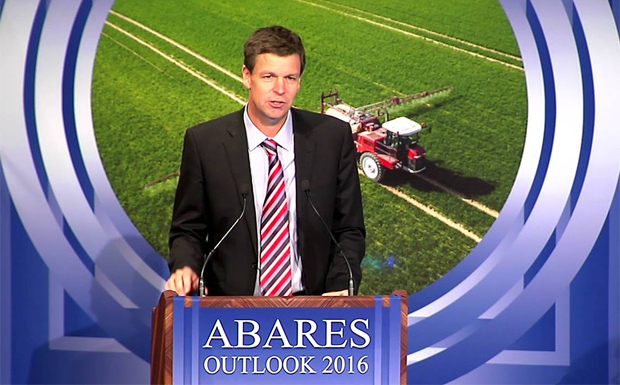
March 6, 2018
The latest ABARES Agricultural Commodities report forecasts a dip in farm production and exports in 2017–18, before steady growth over the next five years.
ABARES Executive Director, Dr Steve Hatfield-Dodds, said the gross value of farm production was estimated to have risen at an annual rate of 2 per cent over the past six years to 2017–18.
The 5 per cent reduction forecast for 2017–18 followed an exceptional 2016–17.
“Our forecast farm production of $59 billion in 2017–18 is largely due to a return towards trend in the gross value of crops from record production in 2016–17,” Dr Hatfield-Dodds said.
“Our price projections for the next five years are influenced by two key drivers.
“Global crop production is trending down from the very high levels of 2016–17 but is expected to be enough to keep stocks high and prices low out to 2022–23, provided no major supply shocks occur.
“For livestock, the US beef cycle has moved to a phase of increased production, intensifying competition in Australia’s export markets.
“For the period to 2022–23, we project this will keep prices below the recent highs associated with US production bottoming out in 2015–16.
“With this flat outlook for prices, growth in the value of agricultural production and exports will come mainly from increased volume, underpinned by rising demand as incomes and populations in importing countries grow.
“An expected 2 per cent increase in the gross value of livestock production in 2017–18 will be driven by global demand for sheep meat, lamb, wool and dairy.
“Steady increases are forecast to follow, with the gross value of farm production to increase by an average of around 1.2 per cent per year to reach nearly $63 billion in 2022–23.
“In 2017–18 the value of farm exports is expected to decline by 4 per cent to $47 billion, before growing steadily to reach $50 billion by 2022–23.”
- A copy of the report is available online
* * *

ABARES Chief Commodity Analyst Peter Gooday, who addressed the ABARES Outlook 2018 conference in Canberra on Tuesday, said farm cash incomes were expected to decline for about half of Australia’s broadacre farms in 2017–18.
This was a result of reduced grain production in most regions and lower prices for beef cattle.
In 2016-17, farm cash income averaged $212,600 per farm. This was the highest farm cash income recorded in the past 20 years and resulted from record winter grain production and high prices for beef cattle.
Farm cash income for broadacre farms is projected to decline to average $191,000 per farm in 2017–18. If achieved, this would be the second highest farm cash income recorded nationally and would be 32 per cent above the average for the previous 10 years.
“For beef farms, average incomes in 2017–18 are expected to decline from $150,000 per farm last year to $132,000 in 2017–18. Beef prices fell globally but remain well above average. Farmers in many regions have offset lower prices through increased turnoff following herd rebuilding efforts over the past couple of years,” Mr Gooday said.
“The sheep industry continues to be a shining light. This year, farm cash incomes are expected to average $170,000 per farm. This is the highest we’ve seen on sheep farms in at least 20 years in real terms and is driven by solid prices for wool and lamb and greater production of sheep meat and wool.
“The dairy industry has also seen big turnaround in farm cash income, up from $89,600 last year to $137,000 in 2017-18, mainly as a result of improved milk prices. However, global supply remains high so there are some risks on the downside in the next couple of years.
“In the grains industry, farm cash incomes have declined this year, with yields returning to more normal levels and prices remaining soft.
“Grain growing regions in Queensland, north-western NSW and the Eyre and Yorke peninsulas in South Australia are projected to record much reduced farm cash incomes due to lower grain production.”






















